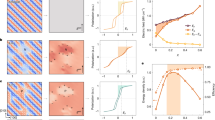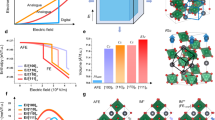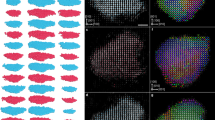Abstract
Ferroelectric materials are characterized by a parallel arrangement of electric dipoles, but at the nanoscale they can present vortices and other non-trivial topological structures1,2,3,4,5,6,7,8,9 that combine small size and topological protection, rendering them functionally attractive10,11,12,13. The driving force for the appearance of vortices in ferroelectrics is the need to minimize the depolarizing fields at interfaces3,4,5,14; by making the polarization rotate, depolarization fields vanish4,5,8,9. Antiferroelectrics, by contrast, are defined by an antiparallel arrangement of electric dipoles15. A priori, therefore, they lack the depolarization fields that drive the appearance of non-trivial topologies in ferroelectrics. At the atomic scale of the dipoles, however, we find that polar discontinuities can still happen, driving the appearance of topological singularities at ferroelastic domain walls.
This is a preview of subscription content, access via your institution
Access options
Access Nature and 54 other Nature Portfolio journals
Get Nature+, our best-value online-access subscription
$32.99 / 30 days
cancel any time
Subscribe to this journal
Receive 12 print issues and online access
$259.00 per year
only $21.58 per issue
Buy this article
- Purchase on SpringerLink
- Instant access to full article PDF
Prices may be subject to local taxes which are calculated during checkout




Similar content being viewed by others
Data availability
All the TEM data are available via the public Sydney eScholarship Repository at https://ses.library.usyd.edu.au/handle/2123/33747. The structure files related to the second-principles simulations in the paper (provided in the POSCAR format), including both structures from relaxations and from 300-K molecular dynamics simulations, are available via the ULiège Open Data Repository at https://doi.org/10.58119/ULG/K6YK6Y.
Code availability
All the first- and second-principles calculations in this study rely on the open-source software ABINIT, DeePMD and LAMMPS (Supplementary Section 3). Pb displacement maps were extracted using the open-access, Python-based Atomap library.
References
Rodriguez, B. J. et al. Vortex polarization states in nanoscale ferroelectric arrays. Nano Lett. 9, 1127–1131 (2009).
Jia, C. L., Urban, K. W., Alexe, M., Hesse, D. & Vrejoiu, I. Direct observation of continuous electric dipole rotation in flux-closure domains in ferroelectric Pb(Zr,Ti)O3. Science 331, 1420–1423 (2011).
Nelson, C. T. et al. Spontaneous vortex nanodomain arrays at ferroelectric heterointerfaces. Nano Lett. 11, 828–834 (2011).
Tang, Y. L. et al. Observation of a periodic array of flux-closure quadrants in strained ferroelectric PbTiO3 films. Science 348, 547–551 (2015).
Yadav, A. K. et al. Observation of polar vortices in oxide superlattices. Nature 530, 198–201 (2016).
Liu, Y. et al. Large scale two-dimensional flux-closure domain arrays in oxide multilayers and their controlled growth. Nano Lett. 17, 7258–7266 (2017).
Das, S. et al. Observation of room-temperature polar skyrmions. Nature 568, 368–372 (2019).
Luk’yanchuk, I., Tikhonov, Y., Razumnaya, A. & Vinokur, V. M. Hopfions emerge in ferroelectrics. Nat. Commun. 11, 2423 (2020).
Luk’yanchuk I., Razumnaya A., Kondovych S., Tikhonov Y. & Vinokur V. M. Topological ferroelectric chirality. Preprint at https://arxiv.org/abs/2406.19728 (2024).
Naumov, I. I., Bellaiche, L. & Fu, H. X. Unusual phase transitions in ferroelectric nanodisks and nanorods. Nature 432, 737–740 (2004).
Jung, H. et al. Logic operations based on magnetic-vortex-state networks. ACS Nano 6, 3712–3717 (2012).
Yadav, A. K. et al. Spatially resolved steady-state negative capacitance. Nature 565, 468–471 (2019).
Balke, N. et al. Enhanced electric conductivity at ferroelectric vortex cores in BiFeO3. Nat. Phys. 8, 81–88 (2012).
Aguado-Puente, P. & Junquera, J. Ferromagneticlike closure domains in ferroelectric ultrathin films: first-principles simulations. Phys. Rev. Lett. 100, 177601 (2008).
Kittel, C. Theory of antiferroelectric crystals. Phys. Rev. 82, 729–732 (1951).
Shirane, G., Sawaguchi, E. & Takagi, Y. Dielectric properties of lead zirconate. Phys. Rev. 84, 476–481 (1951).
Sawaguchi, E., Maniwa, H. & Hoshino, S. Antiferroelectric structure of lead zirconate. Phys. Rev. 83, 1078–1078 (1951).
Corker, D. L., Glazer, A. M., Dec, J., Roleder, K. & Whatmore, R. W. A re-investigation of the crystal structure of the perovskite PbZrO3 by X-ray and neutron diffraction. Acta Cryst. B 53, 135–142 (1997).
Sapriel, J. Domain-wall orientations in ferroelastics. Phys. Rev. B 12, 5128–5140 (1975).
Liu, Y. et al. Controlled growth and atomic-scale mapping of charged heterointerfaces in PbTiO3/BiFeO3 bilayers. ACS Appl. Mater. Interfaces 9, 25578–25586 (2017).
Wang, W. Y. et al. Atomic level 1D structural modulations at the negatively charged domain walls in BiFeO3 films. Adv. Mater. Interfaces 2, 1500024 (2015).
Tang, Y. L. et al. Atomic-scale mapping of dipole frustration at 90° charged domain walls in ferroelectric PbTiO3 films. Sci. Rep. 4, 4115 (2014).
Ma, T., Fan, Z., Tan, X. & Zhou, L. Atomically resolved domain boundary structure in lead zirconate-based antiferroelectrics. Appl. Phys. Lett. 115, 122902 (2019).
Nord, M., Vullum, P. E., MacLaren, I., Tybell, T. & Holmestad, R. Atomap: a new software tool for the automated analysis of atomic resolution images using two-dimensional Gaussian fitting. Adv. Struct. Chem. Imaging 3, 9 (2017).
Liu, Y. et al. Translational boundaries as incipient ferrielectric domains in antiferroelectric PbZrO3. Phys. Rev. Lett. 130, 216801 (2023).
Liu, Y. et al. Atomic coordinates and polarization map around a pair of 1/2 a[01\(\bar{1}\)] dislocation cores produced by plastic deformation in relaxor ferroelectric PIN-PMN-PT. J. Appl. Phys. 129, 234101 (2021).
Cabral, M. J., Chen, Z. & Liao, X. Scanning transmission electron microscopy for advanced characterization of ferroic materials. Microstructures 3, 2023040 (2023).
Moore, K. et al. Charged domain wall and polar vortex topologies in a room-temperature magnetoelectric multiferroic thin film. ACS Appl. Mater. Interfaces 14, 5525–5536 (2022).
Hong, Z. et al. Vortex domain walls in ferroelectrics. Nano Lett. 21, 3533–3539 (2021).
Li, F., Nattermann, T. & Pokrovsky, V. L. Vortex domain walls in helical magnets. Phys. Rev. Lett. 108, 107203 (2012).
Mermin, N. D. The topological theory of defects in ordered media. Rev. Mod. Phys. 51, 591–648 (1979).
Zhang, H. et al. Finite-temperature properties of the antiferroelectric perovskite PbZrO3 from a deep-learning interatomic potential. Phys. Rev. B 110, 054109 (2024).
Shapovalov, K. & Stengel, M. Tilt-driven antiferroelectricity in PbZrO3. Phys. Rev. Mater. 7, L071401 (2023).
Abid, A. Y. et al. Creating polar antivortex in PbTiO3/SrTiO3 superlattice. Nat. Commun. 12, 2054 (2021).
Hu, T. et al. Hierarchical domain structures in (Pb,La)(Zr, Sn, Ti)O3 antiferroelectric ceramics. Ceram. Int. 46, 22575 (2020).
Sánchez-Santolino, G. et al. A 2D ferroelectric vortex pattern in twisted BaTiO3 freestanding layers. Nature 626, 529–534 (2024).
MacLaren, I., Villaurrutia, R., Schaffer, B., Houben, L., & Peláiz-Barranco, A. Atomic-scale imaging and quantification of electrical polarisation in incommensurate antiferroelectric lanthanum-doped lead zirconate titanate. Adv. Funct. Mater. 22, 261–266 (2012).
Fu, Z. et al. Unveiling the ferrielectric nature of PbZrO3-based antiferroelectric materials. Nat. Commun. 11, 3809 (2020).
Ma, T. et al. Uncompensated polarization in incommensurate modulations of perovskite antiferroelectrics. Phys. Rev. Lett. 123, 217602 (2019).
Wei, X.-K., Jia, C.-L., Roleder, K., Dunin-Borkowski, R. E. & Mayer, J. In situ observation of point-defect-induced unit-cell-wise energy storage pathway in antiferroelectric PbZrO3. Adv. Funct. Mater. 31, 2008609 (2021).
Thompson, A. P., Aktulga, H. M. & Berger, R. LAMMPS—a flexible simulation tool for particle-based materials modeling at the atomic, meso, and continuum scales. Comput. Phys. Commun. 271, 108171 (2022).
Acknowledgements
We thank J. Hlinka for insights about domain-wall motion. This work was funded by the FET-Open programme of the EU, project Topological Solitons in Antiferroics (TSAR). Y.L. acknowledges the BIST Postdoctoral Fellowship Programme (PROBIST) funded by the European Union’s Horizon 2020 research and innovation programme under Marie Skłodowska-Curie grant agreement number 754510. ICN2 is supported by the Severo Ochoa Centres of Excellence programme, grant number CEX2021-001214-S. G.C. acknowledges financial support from the Catalan government (grant number 2021 SGR 0129), and from the National Research Agency (Agencia Estatal de Investigación), project number PID2023-148673NB-I00. K.R. was supported by the National Science Centre, Poland, grant number 2022/47/B/ST3/02778. P.G. and K.S. acknowledges support from F.R.S. FNRS Belgium under PDR grant T.0107.20 (PROMOSPAN). H.Z. acknowledges the Research IPD STEMA Program of University of Liège. Simulations were performed at the CECI supercomputer facilities funded by the F.R.S. FNRS (grant number 2.5020.1) and also made use of the Tier-1 supercomputer of the Fédération Wallonie-Bruxelles funded by the Walloon Region (grant number 1117545). We are grateful for the scientific and technical support from the Australian Centre for Microscopy and Microanalysis (ACMM) as well as the Microscopy Australia node at the University of Sydney.
Author information
Authors and Affiliations
Contributions
Y.L., R.N., X.L., J.M.C. and J.A. acquired and analysed the TEM data. K.R. and A.M. made the antiferroelectric single-crystal sample of PbZrO3. H.Z. performed the second-principles atomistic simulations and K.S. performed the continuum simulations of the twin structures: both worked together on the data analysis. Both types of simulation and related interpretation of the results were conducted under the supervision and guidance of P.G. G.C. and Y.L. conceived the study and wrote the first draft. G.C., Y.L., H.Z., K.S. and P.G. revised all subsequent versions of the text and converged the paper.
Corresponding author
Ethics declarations
Competing interests
The authors declare no competing interests.
Peer review
Peer review information
Nature Materials thanks Fangfang Xu and the other, anonymous, reviewer(s) for their contribution to the peer review of this work.
Additional information
Publisher’s note Springer Nature remains neutral with regard to jurisdictional claims in published maps and institutional affiliations.
Extended data
Extended Data Fig. 1 Low-magnification bright-field image showing the ferroelastic domain wall in PZO.
The ferroelastic wall is indicated by a white arrow. The stripes along the pseudocubic <110> directions correspond to translational boundaries.
Extended Data Fig. 2 An STEM-HAADF image showing a twin boundary with the center at PbO plane.
The HAADF image is overlaid by corresponding Pb displacement maps. Head-to-tail Pb displacement configurations are evident.
Extended Data Fig. 3 Oxygen octahedral rotation configuration at a head-to-tail ferroelastic twin boundary.
(a)STEM-HAADF image overlaid with a Pb displacement map (yellow arrows). (b) A STEM-iDPC image showing positions of Pb, Zr, and O atoms. Red lines connect O positions situated between Zr columns in ZrO2 planes along the horizontal direction. The fluctuation magnitude and directional trend of the O-chain indicate both the magnitude and direction of oxygen octahedral rotation. (c) O chain characteristic in PZO single crystal lamella without a twin boundary. The oxygen octahedral rotation angle is defined in the inset as the angle between the line connecting two neighbouring oxygen ions (red line) and the horizontal reference line (yellow dashed line). (d) A rotation map of oxygen octahedra extracted from (b). The sign of O octahedra rotation angle is defined in the inset.
Extended Data Fig. 4 Oxygen octahedral rotation configuration at a head-to-head and tail-to-tail ferroelastic twin boundary.
(a) A STEM-HAADF image overlaid with a Pb displacement map. (b) A STEM-iDPC image showing positions of Pb, Zr, and O ion columns. Red lines connect O positions situated between Zr columns in ZrO2 planes along the horizontal direction. (c) A rotation map of oxygen octahedra.
Extended Data Fig. 5 Second-principles simulation predicted twin boundaries in PZO and the corresponding domain wall energies (EDW).
Each row illustrates one type of twinning boundary: (a) Type-1, (b) Type-2, (c) Type-3, (d) Type-4, (e) Type-5, (f) Type-6, (g) Type-7, and (h) Type-8. The arrows represent local Pb displacements (δPb), with colors indicating their directions. The colors of the squares in the first, second, and third columns correspond to the amplitudes of \({\phi }_{x}={\omega }_{x}{\left(-1\right)}^{{i}_{x}+{i}_{y}+{i}_{z}}\), \({\phi }_{y}={\omega }_{y}{\left(-1\right)}^{{i}_{x}+{i}_{y}+{i}_{z}}\), and \({\omega }_{z}\), respectively. Here, ωx, ωy, ωz are the local oxygen octahedral rotations around the three Cartesian axes, while ix, iy, iz are integers locating the oxygen octahedra.
Extended Data Fig. 7 Distribution of polarisation P(x,y) obtained in the continuum field study of ‘hard’-type twin boundaries.
(a) Head-to-tail and (b) head-to-head dipole configurations. Colour hue and intensity correspond to, respectively, local orientation and magnitude of polarisation. The highest colour intensity corresponds to ~30% of maximum polarisation obtained in the calculations. Inset: colour hue-intensity wheel.
Extended Data Fig. 8 Distribution of tilt ϕ(x,y) obtained from the continuum field study.
(a) “Easy”-type head-to-tail (HtT) twin boundary, (b) “Easy”-type head-to-head (HtH) twin boundary, (c) “Hard”-type HtT twin boundary, and (d) “Hard”-type HtH twin boundary.
Extended Data Fig. 9 Intermediate distribution of polarisation P(x,y) obtained in the continuum-field damped relaxation study based only on polarisation-dependent energy terms.
The highest colour intensity corresponds to ∼30% of maximum polarisation obtained in the calculations. Inset: colour hue-intensity wheel.
Extended Data Fig. 10 Comparative effect of reduced correlation length on continuum-field simulations, and comparison for the cases of head-to-tail wall (Fig. 3(a) of the manuscript) and head-to-head wall (Fig. 3(b) of the manuscript).
Reduced correlation lengths reduce the core size, but not the topological winding number.
Supplementary information
Supplementary Information
Supplementary Sections 1–3, Table 1.1 and Figs. 1–7 and discussions.
Rights and permissions
Springer Nature or its licensor (e.g. a society or other partner) holds exclusive rights to this article under a publishing agreement with the author(s) or other rightsholder(s); author self-archiving of the accepted manuscript version of this article is solely governed by the terms of such publishing agreement and applicable law.
About this article
Cite this article
Liu, Y., Zhang, H., Shapovalov, K. et al. Vortices and antivortices in antiferroelectric PbZrO3. Nat. Mater. 24, 1359–1363 (2025). https://doi.org/10.1038/s41563-025-02245-3
Received:
Accepted:
Published:
Issue date:
DOI: https://doi.org/10.1038/s41563-025-02245-3



